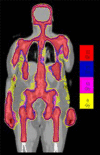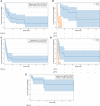Role of radiotherapy in treatment of extramedullary relapse following total marrow and lymphoid irradiation in high-risk and/or relapsed/refractory acute leukemia
- PMID: 36387179
- PMCID: PMC9660291
- DOI: 10.3389/fonc.2022.1017355
Role of radiotherapy in treatment of extramedullary relapse following total marrow and lymphoid irradiation in high-risk and/or relapsed/refractory acute leukemia
Abstract
Background: Total Marrow and Lymphoid Irradiation (TMLI) is a promising component of the preparative regimen for hematopoietic cell transplantation in patients with high-risk acute myeloid leukemia (AML) and acute lymphoid leukemia (ALL). Extramedullary (EM) relapse after TMLI is comparable to TBI and non-TBI conditioning regimens. This study evaluates outcomes of patients treated with radiotherapy (RT) with EM relapse previously treated with TMLI.
Methods: A retrospective analysis of five prospective TMLI trials was performed. TMLI targeted bones and major lymphoid tissues using image-guided tomotherapy, with total dose ranging from 12 to 20 Gy. EM recurrences were treated at the discretion of the hematologist and radiation oncologist using RT ± chemotherapy. Descriptive statistics and survival analysis were then performed on this cohort.
Results: In total, 254 patients with refractory or relapsed AML or ALL were treated with TMLI at our institution. Twenty-one patients were identified as receiving at least one subsequent course of radiation. A total of 67 relapse sites (median=2 sites/patient, range=1-16) were treated. Eleven relapsed patients were initially treated with curative intent. Following the initial course of subsequent RT, 1-year, 3-year and 5-year estimates of OS were 47.6%, 32.7% and 16.3%, respectively. OS was significantly better in patients treated with curative intent, with median OS of 50.7 months vs 1.6 months (p<0.001). 1-year, 3-year and 5-year estimates of PFS were 23.8%, 14.3% and 14.3%, respectively. PFS was significantly better in patients treated with curative intent, with median PFS of 6.6 months vs 1.3 months (p<0.001). Following RT, 86.6% of the sites had durable local control.
Conclusions: RT is an effective modality to treat EM relapse in patients with acute leukemia who relapse after HCT achieving high levels of local control. In patients with limited relapse amenable to curative intent, radiation confers favorable long-term survival. Radiation as salvage treatment for EM relapse after HCT warrants further evaluation.
Keywords: ALL; AML; HCT role of radiation following TMLI; TMLI; leukemia; radiation; relapse; salvage.
Copyright © 2022 Ladbury, Semwal, Hong, Yang, Hao, Han, Liu, Marcucci, Rosenthal, Hui, Salhotra, Ali, Nakamura, Stein, Al Malki, Wong and Dandapani.
Conflict of interest statement
SD has received grant funding from Bayer. The remaining authors declare that the research was conducted in the absence of any commercial or financial relationships that could be construed as a potential conflict of interest.
Figures


Similar articles
-
Extramedullary relapse following total marrow and lymphoid irradiation in patients undergoing allogeneic hematopoietic cell transplantation.Int J Radiat Oncol Biol Phys. 2014 May 1;89(1):75-81. doi: 10.1016/j.ijrobp.2014.01.036. Int J Radiat Oncol Biol Phys. 2014. PMID: 24725691 Clinical Trial.
-
Total marrow irradiation (TMI): Addressing an unmet need in hematopoietic cell transplantation - a single institution experience review.Front Oncol. 2022 Oct 3;12:1003908. doi: 10.3389/fonc.2022.1003908. eCollection 2022. Front Oncol. 2022. PMID: 36263219 Free PMC article. Review.
-
Phase I Trial of Total Marrow and Lymphoid Irradiation Transplantation Conditioning in Patients with Relapsed/Refractory Acute Leukemia.Biol Blood Marrow Transplant. 2017 Apr;23(4):618-624. doi: 10.1016/j.bbmt.2017.01.067. Epub 2017 Jan 10. Biol Blood Marrow Transplant. 2017. PMID: 28087456 Free PMC article. Clinical Trial.
-
The safety and efficacy of a novel hypo-fractionated total marrow and lymphoid irradiation before allogeneic stem cell transplantation for lymphoma and acute leukemia.Clin Transl Radiat Oncol. 2020 Nov 12;26:42-46. doi: 10.1016/j.ctro.2020.11.004. eCollection 2021 Jan. Clin Transl Radiat Oncol. 2020. PMID: 33305023 Free PMC article.
-
Maintain Efficacy and Spare Toxicity: Traditional and New Radiation-Based Conditioning Regimens in Hematopoietic Stem Cell Transplantation.Cancers (Basel). 2024 Feb 21;16(5):865. doi: 10.3390/cancers16050865. Cancers (Basel). 2024. PMID: 38473227 Free PMC article. Review.
Cited by
-
Total marrow lymphoid irradiation IMRT treatment using a novel CT-linac.Eur J Med Res. 2023 Oct 27;28(1):463. doi: 10.1186/s40001-023-01380-4. Eur J Med Res. 2023. PMID: 37884978 Free PMC article.
References
-
- Wong JYC, Forman S, Somlo G, Rosenthal J, Liu A, Schultheiss T, et al. . Dose escalation of total marrow irradiation with concurrent chemotherapy in patients with advanced acute leukemia undergoing allogeneic hematopoietic cell transplantation. Int J Radiat Oncol Biol Phys (2013) 85(1):148–56. Elsevier. doi: 10.1016/j.ijrobp.2012.03.033 - DOI - PMC - PubMed
-
- Rosenthal J, Wong J, Stein A, Qian D, Hitt D, Naeem H, et al. . Phase 1/2 trial of total marrow and lymph node irradiation to augment reduced-intensity transplantation for advanced hematologic malignancies. Blood: Content Repository Only!; (2011) 117(1): 309–15. doi: 10.1182/blood-2010-06-288357 - DOI - PMC - PubMed
-
- Lee KH, Lee JH, Choi SJ, Lee JH, Kim S, Seol M, et al. . Bone marrow vs extramedullary relapse of acute leukemia after allogeneic hematopoietic cell transplantation: Risk factors and clinical course. Bone Marrow Transplant (2003) 32(8):835–42. Nature Publishing Group. doi: 10.1038/sj.bmt.1704223 - DOI - PubMed
LinkOut - more resources
Full Text Sources

